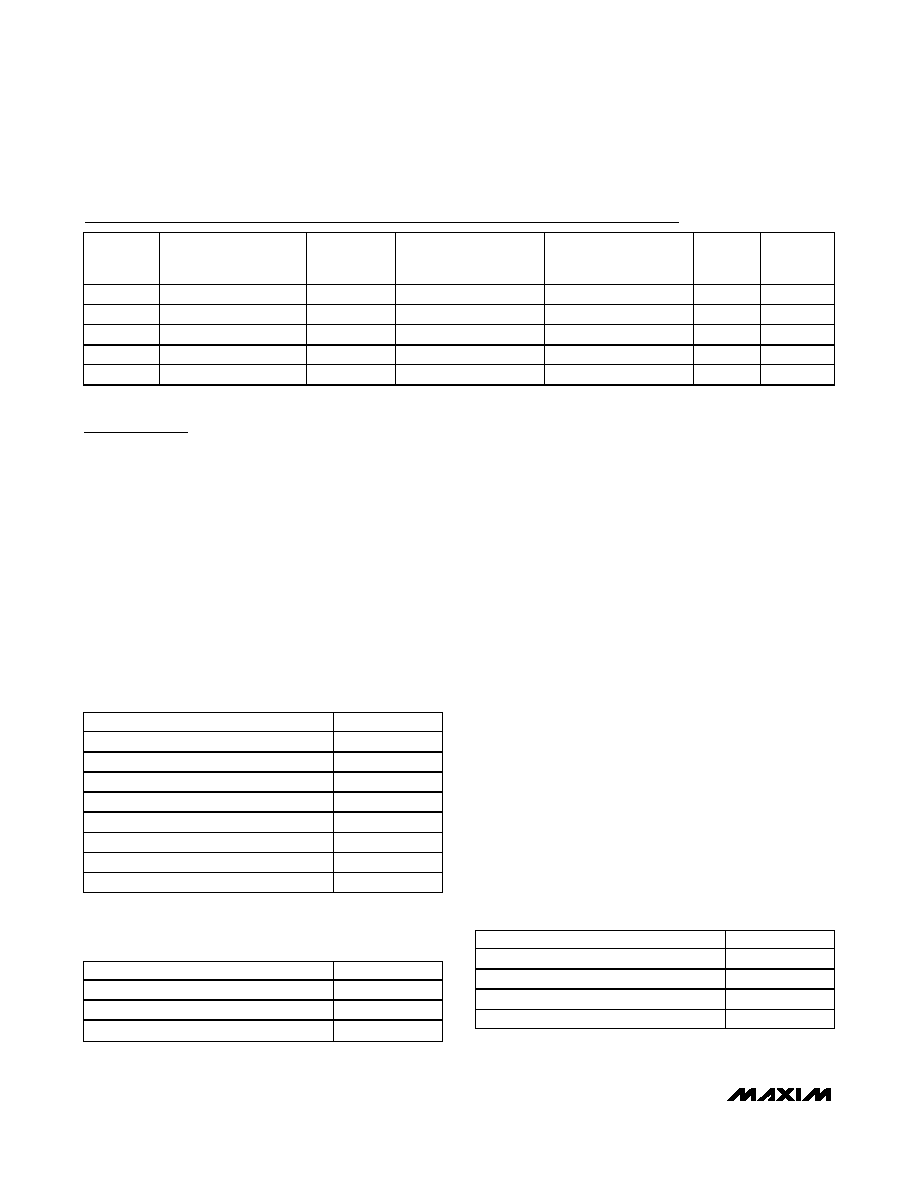- 您現(xiàn)在的位置:買賣IC網(wǎng) > PDF目錄45178 > MAX7391CNTP (MAXIM INTEGRATED PRODUCTS INC) 8 MHz, OTHER CLOCK GENERATOR, PDSO8 PDF資料下載
參數(shù)資料
| 型號: | MAX7391CNTP |
| 廠商: | MAXIM INTEGRATED PRODUCTS INC |
| 元件分類: | 時鐘產(chǎn)生/分配 |
| 英文描述: | 8 MHz, OTHER CLOCK GENERATOR, PDSO8 |
| 封裝: | MO-187C-AA, MICRO, SOP-8 |
| 文件頁數(shù): | 11/12頁 |
| 文件大小: | 594K |
| 代理商: | MAX7391CNTP |

MAX7391
Speed-Switching Clock Generator
with Power Fail
8
_______________________________________________________________________________________
Applications Information
Interfacing to a Microcontroller
Clock Input
The clock output is a push-pull, CMOS logic output,
which directly drives any microprocessor (P) or micro-
controller (C) clock input. There are no impedance-
matching issues when using the MAX7391. Operate the
MAX7391 and C (or other clock input device) from the
same supply voltage level. Refer to the microcontroller
data sheet for clock-input compatibility with external
clock signals. Table 3 lists clock output frequency.
The MAX7391 requires no biasing components or load
capacitance. When using the MAX7391 to retrofit a
crystal oscillator, remove all biasing components from
the oscillator input.
Power-Supply Considerations
The MAX7391 operates with power-supply voltages in
the 2.7V to 5.5V range. Good power-supply decoupling
is needed to maintain the power-supply rejection per-
formance of the MAX7391. Bypass VCC to GND with a
0.1F surface-mount ceramic capacitor. Mount the
bypass capacitor as close to the device as possible. If
possible, mount the MAX7391 close to the microcon-
troller’s decoupling capacitor so that additional decou-
pling is not required.
A larger-value bypass capacitor is recommended if the
MAX7391 is to operate with a large capacitive load.
Use a bypass capacitor value of at least 1000 times
that of the output load capacitance.
Output Jitter
The MAX7391’s jitter performance is given in the
Electrical Characteristics table as a peak-to-peak value
obtained by observing the output of the device for 20s
with a 500MHz oscilloscope. Jitter measurements are
approximately proportional to the period of the output
frequency of the device. Thus, a 4MHz part has approx-
imately twice the jitter value of an 8MHz part.
The jitter performance of all clock sources degrades in
the presence of mechanical and electrical interference.
The MAX7391 is immune to vibration, shock, and EMI
influences, and thus provides a considerably more
robust clock source than crystal- or ceramic-resonator-
based oscillator circuits.
Table 1. POR Voltage
POWER-ON RESET VOLTAGE (VTH)
r
4.38
M
3.96
J
3.44
N
3.34
P
3.13
Q
2.89
S
2.82
V
2.5
X
Table 2. Reset Output Type
OUTPUT TYPE
s
Push-pull RST
A
Push-pull RST
B
Open collector
RST
C
Table 3. Clock Output Frequency
CLOCK FREQUENCY (fCLOCK) (MHz)
ff
4RD
8TP
12
VB
16
WB
Note: Contact factory for other frequencies.
Note: Standard values are shown in bold. Contact factory for
other POR voltages.
Note: Standard values are shown in bold. Contact factory for
other output types.
Note: Other versions with different features are available. Refer to the MAX7387/MAX7388 and MAX7389/MAX7390 data sheets.
Selector Guide
PART
FREQUENCY RANGE
(MHz)
RESET
FUNCTION
WATCHDOG INPUT
(WDI) / WATCHDOG
OUTPUT (
WDO)
POWER-FAIL INPUT
(PFI)/POWER-FAIL
OUTPUT (PFO)
SPEED
PIN-
PACKAGE
MAX7387
1 to 32
Yes
Yes/yes
—
10 MAX
MAX7388
1 to 32
Yes
Yes/no
No/yes
—
8 MAX
MAX7389
1 to 32
Yes
Yes/yes
—
8 MAX
MAX7390
1 to 32
Yes
Yes/no
—
Yes
8 MAX
MAX7391
1 to 32
Yes
—
Yes/yes
Yes
8 MAX
相關(guān)PDF資料 |
PDF描述 |
|---|---|
| MAX7391ANRD | 4 MHz, OTHER CLOCK GENERATOR, PDSO8 |
| MAX7391BQRD | 4 MHz, OTHER CLOCK GENERATOR, PDSO8 |
| MAX7391AMRD | 4 MHz, OTHER CLOCK GENERATOR, PDSO8 |
| MAX7391BJRD | 4 MHz, OTHER CLOCK GENERATOR, PDSO8 |
| MAX7391CVWB | 16 MHz, OTHER CLOCK GENERATOR, PDSO8 |
相關(guān)代理商/技術(shù)參數(shù) |
參數(shù)描述 |
|---|---|
| MAX7391CSAC | 功能描述:時鐘發(fā)生器及支持產(chǎn)品 RoHS:否 制造商:Silicon Labs 類型:Clock Generators 最大輸入頻率:14.318 MHz 最大輸出頻率:166 MHz 輸出端數(shù)量:16 占空比 - 最大:55 % 工作電源電壓:3.3 V 工作電源電流:1 mA 最大工作溫度:+ 85 C 安裝風(fēng)格:SMD/SMT 封裝 / 箱體:QFN-56 |
| MAX7391CSRD | 功能描述:時鐘發(fā)生器及支持產(chǎn)品 RoHS:否 制造商:Silicon Labs 類型:Clock Generators 最大輸入頻率:14.318 MHz 最大輸出頻率:166 MHz 輸出端數(shù)量:16 占空比 - 最大:55 % 工作電源電壓:3.3 V 工作電源電流:1 mA 最大工作溫度:+ 85 C 安裝風(fēng)格:SMD/SMT 封裝 / 箱體:QFN-56 |
| MAX7391CSRD-T | 制造商:Maxim Integrated Products 功能描述:SPEED-SWITCHING CLOCK GENERATOR WIT - Tape and Reel |
| MAX7391CSTP | 功能描述:時鐘發(fā)生器及支持產(chǎn)品 RoHS:否 制造商:Silicon Labs 類型:Clock Generators 最大輸入頻率:14.318 MHz 最大輸出頻率:166 MHz 輸出端數(shù)量:16 占空比 - 最大:55 % 工作電源電壓:3.3 V 工作電源電流:1 mA 最大工作溫度:+ 85 C 安裝風(fēng)格:SMD/SMT 封裝 / 箱體:QFN-56 |
| MAX7391CSTP-T | 制造商:Maxim Integrated Products 功能描述:SPEED-SWITCHING CLOCK GENERATOR WIT - Tape and Reel |
發(fā)布緊急采購,3分鐘左右您將得到回復(fù)。